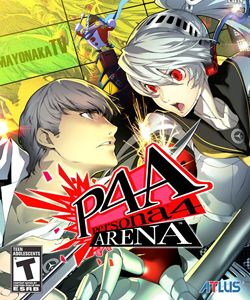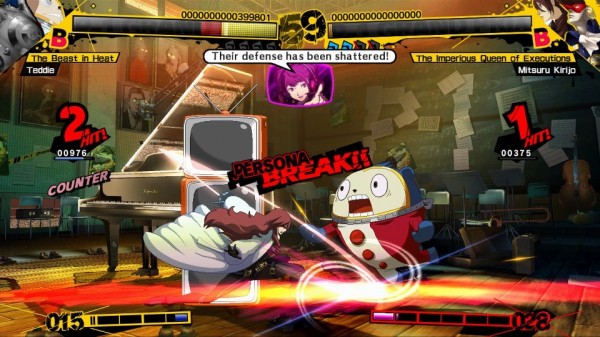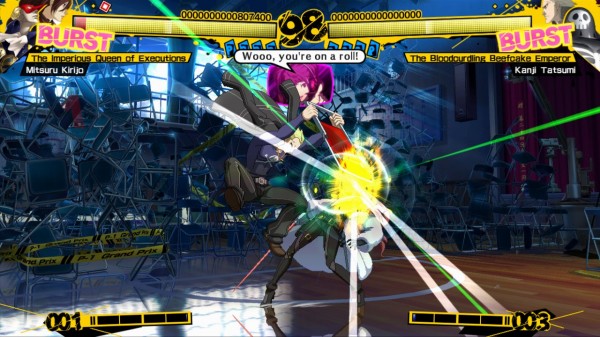This was a series of 100-plus hour RPGs that was about to transcend its genre for a new frontier. The risk is nothing to scoff at; this game would need to lure fighting fans to a brand new name in the ring, while providing quality character narratives for its own established fan-base. If it failed in either of these two tasks, then half of the intended audience would be lost.
Luckily, that’s not going to happen. Persona 4 Arena is exactly what I would expect from both entities. The Persona experience complements an intricate and intuitive fighting system that’s easy to play and hard to master, two qualities that fighting game fans LOVE to see. The game’s story is Persona through and through, with both the arcade and “campaign” containing elements of the narrative. Most of all, it’s filled with the personality and quirkiness that Persona fans have enjoyed for years. Atlus and Arc System Works have done it; Persona 4 Arena is a triumph worthy of both the Persona name and the 2D fighting genre.
First, a quick primer for those unfamiliar: Shin Megami Tensei: Persona is a series of RPGs that centers around demon summoning. The main cast of characters can call upon these demons to aid them in battle. The demons are called “Persona” due to their being a representation of one particular facet of the summoner’s psyche. Each of the Persona games have their own unique stories; Persona 4, which P4A takes most of its material from, follows a group of high school students investigating a series of murders involving the “TV World” and malevolent monsters known as “Shadows.”
Follow all that? It’s a bit difficult to explain so briefly, but the stories are quite intriguing, believe me. Now back to Persona 4 Arena.
This unconventional blend of RPG and fighting ideas is a mechanical surprise. The four-button layout is split into two parts: A and B are strictly attacks by the characters on the screen, and C and D call out the Persona at any time. I had originally suspected that the Persona would be reserved for flashy hyper combos, but thankfully I was wrong. However, overusing Persona does not come without cost, as four direct attacks on the Persona will cause a “Persona Break,” rendering the player unable to summon the Persona for a short period of time. It’s an ingenious way to allow two characters to be controlled at once, creating an unique and interesting control scheme along the way.
Aside from the dual-character approach, the rest of the controls are standard 2D fighting fare. There will be quarter circles forward and backward, the occasional charge move, and double quarter circles for the big-time moves. That doesn’t mean that Persona 4 Arena is lacking originality. Mortal Blows, a new idea to the fighting realm, can kill an opponent in one attack so long as a few prerequisites are met. All Out Rush creates a guessing game where one character can either knock an opponent up for an air combo or launch them away creating space. These are both unique, but the coolest new element Persona 4 Arena employs is Status Ailments. Yes, making the trip from RPG to fighting game are effects like Silence (Persona cannot be summoned), Poison (damage over time), Rage (block disabled but damage increased), and more, all of which will add to the strategic element of combat. The best ailment by far is Negative Penalty, which scales damage up for a character if the player is playing too defensively. Hear that turtlers, back-dashers, and constant blockers? YOUR TIME HAS COME.
The game’s story mode is an epic undertaking. Each of the thirteen playable characters have their own chapter in the story. The chapters each consist of eight one-round matches separated by spoken dialogue to advance the story. While the characters are interesting, the plot intriguing…
…the structure is just plain off.
Every scene involves dialogue and monologue delivered in staccato such as this.
Sometimes it’s one scene between battles…
…other times it could be twenty full minutes of this stuff.
At first it’s very RPG-like, perfect for the Persona series, naturally. Eventually, though, when a player remembers this is a FIGHTING game, the scenes can be quite long-winded, especially when multiple scenes follow one another. Then a match finally does start, it ends far too quickly, and the talking begins again.
I’m not sure where problem exactly lies…
…it could be in the one-round match format, as a two-round match may have felt more impactful…
…perhaps it’s the almanac of dialogue between fights…
…or maybe I’m just impatient.
Whatever it is, the format can get annoying quickly for those who aren’t expecting it. Thankfully the Arcade mode presents the story in a much more brief manner, making the narrative much easier to swallow.
The distinct cheekiness of the Persona franchise was not left behind in RPG land, as there were a few moments that had me chuckling. One of the first bits of dialogue in Yu’s story sees Teddie (the spherical “teddy bear” well known to Persona fans) asking Yu to bring him home a nurse-themed adult magazine. Later on, when the first TV “commercial” for the fighting tournament is shown, each character is given some of the greatest nicknames of all time.
“Carnivore Who’s Discarded Womanhood” (Chie Satonaka). “The Raging Bull of Destruction’ (Shadow Labrys). I can’t decide which is my favorite. I’m stuck between “The Beast In Heat” (Teddie) or “The Bloodcurdling Beefcake Emperor” (Kanji Tatsumi). Keen eyes can also find nods to other Persona Team games throughout the story mode, like the calendar featuring Catherine from last year’s tower-climbing escapade in Yu’s bedroom. It seems that no matter the genre, the wittiness and irreverence of Persona will continue, and that can only be a good thing.
Speaking of “genre,” what does it say about a series or its creators that it can be adapted from one genre to a radically different one while maintaining the level of excellence that fans expect? Persona had made its mark on the RPG world with four epic games, so fans have come to expect that every time a new game comes out. Even when the re-released Persona games hit the PSP and PSN, players ate them up because they knew the type of game they were getting. Now, the creators decide “eh, let’s take a break from RPGs and make a FIGHTING GAME” and it’s just as good as the series it was born from. Is that a nod to the development team’s creativity or the versatility of the series itself? I’d like to think both, but the fact that Persona could genre-hop so effectively could set a precedent for other games to try and make a jump.
“Bloodcurdling Beefcake Emperor” out.




















